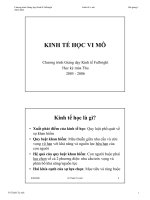Bài giảng kinh tế vi mô chap10 premium
Bạn đang xem bản rút gọn của tài liệu. Xem và tải ngay bản đầy đủ của tài liệu tại đây (495.2 KB, 44 trang )
10
Externalities
PRINCIPLES OF
FOURTH EDITION
N. G R E G O R Y M A N K I W
PowerPoint® Slides
by Ron Cronovich
© 2007 Thomson South-Western, all rights reserved
In this chapter, look for the answers to these
questions:
What is an externality?
Why do externalities make market outcomes
inefficient?
How can people sometimes solve the problem of
externalities on their own? Why do such private
solutions not always work?
What public policies aim to solve the problem of
externalities?
CHAPTER 10
EXTERNALITIES
2
Introduction
Recall one of the Ten Principles from Chap. 1:
Markets are usually a good way
to organize economic activity.
Lesson from Chapter 7:
In the absence of market failures,
the competitive market outcome is efficient,
maximizes total surplus.
CHAPTER 10
EXTERNALITIES
3
Introduction
One type of market failure: externalities.
Externality: the uncompensated impact of
one person’s actions on the well-being of a
bystander
• Negative externality:
the effect on bystanders is adverse
• Positive externality:
the effect on bystanders is beneficial
CHAPTER 10
EXTERNALITIES
4
Introduction
Self-interested buyers and sellers
neglect the external effects of their actions,
so the market outcome is not efficient.
Another principle from Chapter 1:
Governments can sometimes
improve market outcomes.
CHAPTER 10
EXTERNALITIES
5
Pollution: A Negative Externality
Example of negative externality:
Air pollution from a factory.
• The firm does not bear the
full cost of its production,
and so will produce
more than the
socially efficient quantity.
How govt may improve
the market outcome:
• Impose a tax on the firm equal to the
external cost of the pollution it generates
CHAPTER 10
EXTERNALITIES
6
Other Examples of Negative Externalities
the neighbor’s barking dog
late-night stereo blasting from the dorm room
next to yours
noise pollution from construction projects
talking on cell phone while driving makes the
roads less safe for others
health risk to others from second-hand smoke
CHAPTER 10
EXTERNALITIES
7
Positive Externalities from Education
A more educated population benefits society:
• lower crime rates:
educated people have more
opportunities, so less likely to rob and steal
• better government:
educated people make
better-informed voters
People do not consider these external benefits
when deciding how much education to “purchase”
Result: market eq’m quantity of education too low
How govt may improve the market outcome:
• subsidize cost of education
CHAPTER 10
EXTERNALITIES
8
Other Examples of Positive Externalities
Being vaccinated against
contagious diseases
protects not only you,
but people who visit the
salad bar or produce section
after you.
R&D creates knowledge
others can use
Renovating your house
increases neighboring
property values
CHAPTER 10
EXTERNALITIES
Thank you for
not contaminating
the fruit supply!
9
Recap of Welfare Economics
The market for gasoline
P
$5
4
Supply curve shows
private cost, the costs
directly incurred by sellers
3
$2.50
2
Demand curve shows
private value, the value
to buyers (the prices they
are willing to pay)
1
0
The market eq’m
maximizes consumer
+ producer surplus.
0
CHAPTER 10
10
20 25 30 Q
(gallons)
EXTERNALITIES
10
Analysis of a Negative Externality
The market for gasoline
P
$5
Social cost
= private + external cost
4
external
cost
Supply (private cost)
3
External cost
= value of the
negative impact
on bystanders
2
1
0
0
CHAPTER 10
10
20
EXTERNALITIES
30 Q
(gallons)
= $1 per gallon
(value of harm
from smog,
greenhouse gases)
11
Analysis of a Negative Externality
The market for gasoline
P
$5
Social
cost
4
S
3
2
1
0
The
The socially
socially
optimal
optimal quantity
quantity
is
is 20
20 gallons.
gallons.
0
CHAPTER 10
10
At
At any
any Q
Q << 20,
20,
value
value of
of additional
additional gas
gas
exceeds
exceeds social
social cost
cost
At any
any Q
Q >> 20,
20,
D At
social
social cost
cost of
of the
the
last
last gallon
gallon is
is
greater
greater than
than its
its value
value
20 25 30 Q
(gallons)
EXTERNALITIES
12
Analysis of a Negative Externality
The market for gasoline
P
$5
Social
cost
4
S
3
2
D
1
0
0
CHAPTER 10
10
20 25 30 Q
(gallons)
EXTERNALITIES
Market eq’m
(Q = 25)
is greater than
social optimum
(Q = 20)
One solution:
tax sellers
$1/gallon,
would shift
supply curve
up $1.
13
“Internalizing the Externality”
Internalizing the externality: altering incentives
so that people take account of the external effects
of their actions
In the previous example, the $1/gallon tax on
sellers makes sellers’ costs equal to social costs.
When market participants must pay social costs,
the market eq’m matches the social optimum.
(Imposing the tax on buyers would achieve the
same outcome; market Q would equal optimal Q.)
CHAPTER 10
EXTERNALITIES
14
Positive Externalities
In the presence of a positive externality,
the social value of a good includes
• private value – the direct value to buyers
• external benefit – the value of the
positive impact on bystanders
The socially optimal Q maximizes welfare:
• At any lower Q, the social value of
additional units exceeds their cost.
• At any higher Q, the cost of the last unit
exceeds its social value.
CHAPTER 10
EXTERNALITIES
15
1:
Analysis of a positive externality
ACTIVE LEARNING
P The market for flu shots
External benefit
= $10/shot
$50
Draw the social
40
value curve.
S
30
Find the socially
optimal Q.
20
What policy would
10
internalize this
externality?
D
0
0
10
20
30
Q
16
ACTIVE LEARNING
Answers
1:
Socially optimal Q
= 25 shots
P The market for flu shots
$50
To internalize the
externality, use
subsidy = $10/shot.
external
benefit
40
S
30
Social value
= private value
+ external benefit
20
10
D
0
0
10
20 25 30
Q
17
Effects of Externalities: Summary
IfIf negative
negative externality
externality
market
market produces
produces aa larger
larger quantity
quantity
than
than is
is socially
socially desirable
desirable
IfIf positive
positive externality
externality
market
market produces
produces aa smaller
smaller quantity
quantity
than
than is
is socially
socially desirable
desirable
To
To remedy
remedy the
the problem,
problem,
“internalize
“internalize the
the externality”
externality”
tax
tax goods
goods with
with negative
negative externalities
externalities
subsidize
subsidize goods
goods with
with positive
positive externalities
externalities
CHAPTER 10
EXTERNALITIES
18
Private Solutions to Externalities
Types of private solutions:
moral codes and social sanctions,
e.g., the “Golden Rule”
charities, e.g., the Sierra Club
contracts between market participants and the
affected bystanders
CHAPTER 10
EXTERNALITIES
19
Private Solutions to Externalities
The Coase theorem:
If private parties can bargain without cost over
the allocation of resources, they can solve the
externalities problem on their own.
CHAPTER 10
EXTERNALITIES
20
The Coase Theorem: An Example
Dick owns a dog named Spot.
Negative externality:
Spot’s barking disturbs Jane,
Dick’s neighbor.
The socially efficient outcome
maximizes Dick’s + Jane’s well-being.
• If Dick values having Spot more
than Jane values peace & quiet,
the dog should stay.
See Spot bark.
Coase theorem: The private market will reach the
efficient outcome on its own…
CHAPTER 10
EXTERNALITIES
21
The Coase Theorem: An Example
CASE 1:
Dick has the right to keep Spot.
Benefit to Dick of having Spot = $500
Cost to Jane of Spot’s barking = $800
Socially efficient outcome:
Spot goes bye-bye.
Private outcome:
Jane pays Dick $600 to get rid of Spot,
both Jane and Dick are better off.
Private outcome = efficient outcome.
CHAPTER 10
EXTERNALITIES
22
The Coase Theorem: An Example
CASE 2:
Dick has the right to keep Spot.
Benefit to Dick of having Spot = $1000
Cost to Jane of Spot’s barking = $800
Socially efficient outcome:
See Spot stay.
Private outcome:
Jane not willing to pay more than $800,
Dick not willing to accept less than $1000,
so Spot stays.
Private outcome = efficient outcome.
CHAPTER 10
EXTERNALITIES
23
The Coase Theorem: An Example
CASE 3:
Benefit to Dick of having Spot = $500
Cost to Jane of Spot’s barking = $800
But Jane has the legal right to peace & quiet.
Socially efficient outcome: Dick keeps Spot.
Private outcome:
Dick pays Jane $600 to put up with Spot’s barking.
Private outcome = efficient outcome.
The
The private
private market
market achieves
achieves the
the efficient
efficient outcome
outcome
regardless
regardless of
of the
the initial
initial distribution
distribution of
of rights.
rights.
CHAPTER 10
EXTERNALITIES
24
ACTIVE LEARNING
Brainstorming
2:
Collectively, the 1000 residents of Green Valley
value swimming in Blue Lake at $100,000.
A nearby factory pollutes the lake water, and would
have to pay $50,000 for non-polluting equipment.
A. Describe a Coase-like private solution.
B. Can you think of any reasons why this solution
might not work in the real world?
25









